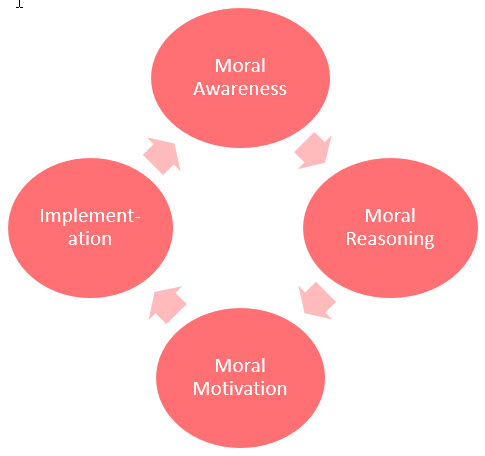What is the P score?
A score known as the ‘Principled Morality Score’ or P-score (Rest, 1979) provides an indication of the level of moral judgment development across six stages of moral reasoning (as indicated in Figure 1 below) by representing the percentage of post-conventional reasoning (stages 5 and 6) preferred by the respondent. In this sense, the importance is placed not so much on the decision itself, but on the ‘reasoning’ that guides the decision.

Source: Adapted from Kohlberg, 1963; Rest and Narvaez, 1994: p.5; Rest et al, 1999; Kohlberg and Hersh, 1977
Figure 1: Six Stages of Moral Judgment Development
The P-score is calculated by dividing the number of points allocated to post-conventional items by the total number of points available (usually 60). P-scores can range from 0% to 95%. In the United States, a study by Bigel (2000) found Certified Financial Planners who held a qualification at bachelors level or higher to have an average P-score of 40 which is the same as that reported for adults in general (Rest, 1994).
The four psychological components in Figure 2 below are postulated to be pre-requisites of moral behaviour. Moral awareness means that a person is capable of recognising that a moral situation exists. How a person makes judgments about a moral situation is known as their moral reasoning and what motivates a person to take action is a person’s moral motivation. The Principled Morality Score measures the moral reasoning component.

Figure 2: Four Component Model (adapted from Rest et al., 1986)
References
Bigel K 2000, ‘The ethical orientation of financial planners who are engaged in investment activities: A comparison of United States practitioners based on professionalization and compensation sources’, Journal of Business Ethics, vol 28 (4), 323-337.
Kohlberg, L. (1963). The development of children's orientations toward a moral order: I. Sequence in the development of moral thought. Vita Humana, 6(1-2), 11–33
Kohlberg L and Hersh R 1977, ‘Moral development: A review of the theory’, Theory Into Practice, vol 16 (2), 53-59Rest J 1979, Development in Judging Moral Issues, University of Minnesota Press, Minneapolis, MN, USA
Rest J 1986, Moral Development: Advances in Research and Theory, Praeger Publishers, New York.
Rest J 1994, ‘Background: Theory and Research’ in Rest J and D Narvaez (Eds), Moral Development in the Professions: Psychology and Applied Ethics, Lawrence Erlbaum Associates Inc., New Jersey, 14-19.
Rest J, Bebeau M and Volker J 1986, ‘An Overview of the Psychology of Morality’ in Rest (Ed), Moral Development: Advances in Research and Theory, Praeger Publishers, New York.
Rest L and Narvaez D (Eds) 1994, Moral Development in the Professions: Psychology and Applied Ethics, Lawrence Erlbaum Associates Inc., New Jersey
Rest J, Narvaez D, Thoma S and Bebeau M 1999, ‘DIT2: Devising and Testing a Revised Instrument of Moral Judgement’, Journal of Educational Psychology, vol 91 (4), 644-659. DOI: 854607681.
This information has been contributed by Dr Michelle Cull, School of Business, Western Sydney University. Dr Cull can be contacted at m.cull@westernsydney.edu.au
Mobile options:

